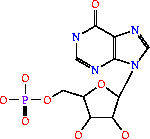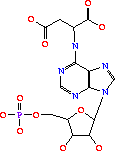Introduction
Adenylosuccinate Synthetase (AdSS, EC number 6.3.4.4) or deoxyguanylosuccinate synthase is part of the Ligase family of enzymes[1]. Ligase enzymes commonly 'glue' two different molecules together and create a new chemical bond.
Its systematic name is IMP:L-aspartate ligase. It is mainly involved in purine bio-synthesis. It does this by catalyzing the GTP dependent changeover of IMP and aspartic acid to AMP in the presense of Mg2+.[2] In Humans, AdSS catalyzes the first committed step in the purine nucleotide cycle by the de novo synthesis of adenosine monophosphate.[3]
AdSS (3hid) was isolated from Yersinia pestis CO92and can be found in a variety of organisms ranging from yeast to bacteria to humans. Its crystal structure was determined using x-ray diffraction at a resolution of 1.60 Angstoms. . The gene is located on chromosome 1 q44, in humans and is expressed in the majority of an organisms cells. See also Ligases.
Structure
The AdSS enzyme is a dimer consisting of two identical monomeric subunits. The main structural component of each monomer is a centrally located beta sheet that is comprised of 10 strands. Nine of the 10 strands are parallel while the 10th strand is anti-parallel with respect to the other 9 strands. There are also several other secondary structures including 2 small 3/10 helices and two anti-parallel sheets consisting of 2 and 3 strands respectively. Additionally there are 11 alpha helices.[4] AdSS has three major binding sites, one for GTP, one for IMP and its active site. The active site, ligand molecules in orange can be seen .
The major fold of this protein is unique and has not been documented in any other type of protein. The active site itself consists of a crevice consisting of Gly12, Gly15, Gly17, Lys18, Ile19, and Lys331. The other side of the crevice contains Lysine 140 and Arg147, which are located in the region between the two monomers. Asp231 is bonded to Lys140 in a salt bridge and its carbonyl atom is hydrogen bonded to Arg147. Also, none of cysteine residues are bound to each other in disulphide bonds.[4]
Helices are highlighted in green and beta sheets are shown in orange .
AdSS has an optimal pH of 6.5 and a denatures at pH 7.4.[5] It has a melting point of 85 degrees Celsius.[6]
Reaction Mechanism
AdSS undergoes the following amination reaction:
GTP + IMP + L-Asp -> GDP + phosphate + N6-(1,2-dicarboxyethyl)-AMP[7]
 +
+  +
+ ->
->  +
+  +
+ 
The 6-O of inosine is displaced by aspartate which yields adenylosuccinate. The presence, or over abundance of AMP, GMP, GDP and adenylosuccinate acts as a feedback inhibitor for AdSS.[8]
Binding of GTP alone is not sufficient to induce a conformational change in the enzyme. IMP, coupled with an acetate ion invoke a conformational change which helps prepare the active site for catalysis. The reaction proceeds as follows: The gamma phosphoryl group of GTP is transferred to the 6-keto group of IMP which causes the displacement of an inorganic phosphorus molecule, Pi, from L-Aspartate. This leads to the formation of an adenylosuccinate molecule.[9]
Medical Implications
Defects in the gene product can result in a wide variety of diseases such as Acidosis, Gout, Neoplasms, Sarcoma, Leukemia and Lymphoma[10]. Since AdSS plays a crucial role in purine catalysis, it is a choice target for anti tumor drugs and antibiotics. A variety of enzymes are found to be improperly balanced in cancer cells, including AdSS which is found to be over expressed 5.5 times as much as it would normally be.[11]
3D structures of adenylosuccinate synthetase
Adenylosuccinate synthetase 3D structures






